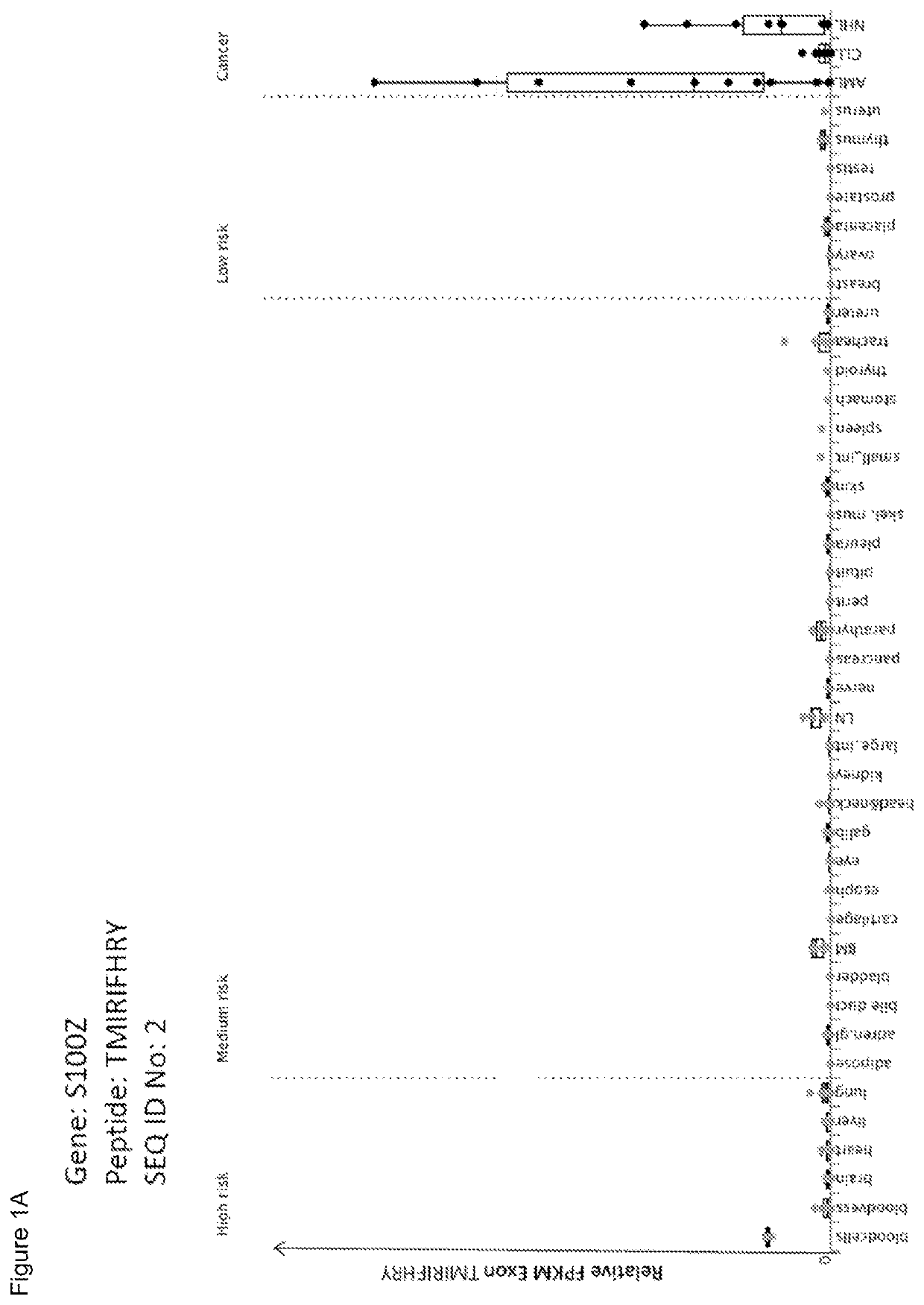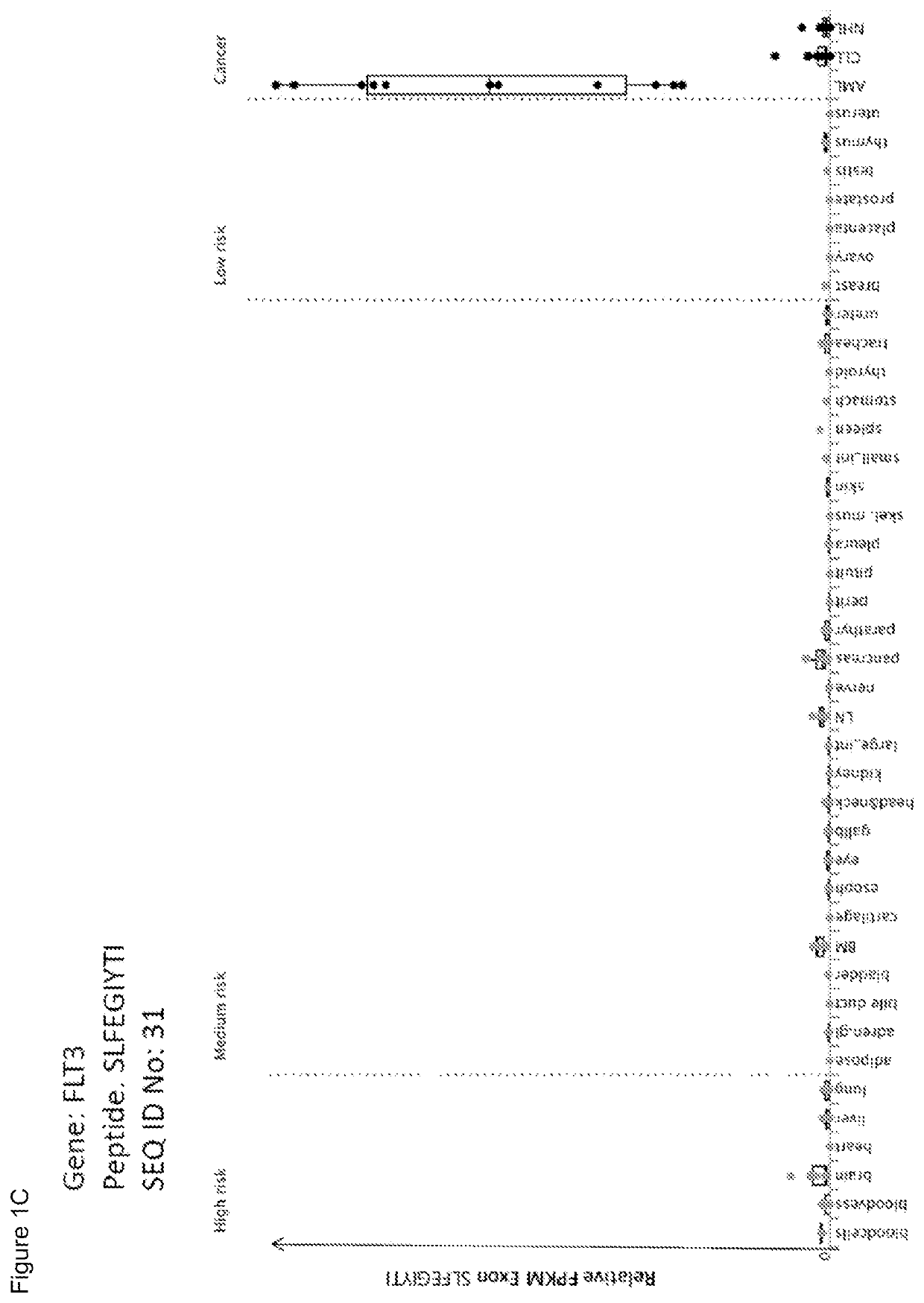Peptides and combination of peptides for use in immunotherapy against leukemias and other cancers
a technology of immunotherapy and peptides, which is applied in the direction of peptides, immunological disorders, drug compositions, etc., can solve the problems of increasing the risk of secondary resistance, only showing slow progression of disease or worsening symptoms, and a significant cos
- Summary
- Abstract
- Description
- Claims
- Application Information
AI Technical Summary
Benefits of technology
Problems solved by technology
Method used
Image
Examples
example 1
[0367]Identification of Tumor Associated Peptides Presented on the Cell Surface
[0368]Tissue Samples
[0369]Patients' tumor samples and normal tissues were obtained from the University Hospital Tübingen (Tübingen, Germany). Written informed consents of all patients had been given before blood draw. PBMC were isolated from blood samples using Ficoll-Hypaque density gradient centrifugation immediately after blood draw. PBMC pellets were shock-frozen immediately after purification and stored until isolation of TUMAPs at −70° C. or below.
[0370]Isolation of HLA Peptides from Tissue Samples
[0371]HLA peptide pools from shock-frozen samples were obtained by immune precipitation according to a slightly modified protocol (Falk et al., 1991; Seeger et al., 1999) using the HLA-A*02-specific antibody BB7.2, the HLA-A, -B, C-specific antibody W6 / 32, CNBr-activated sepharose, acid treatment, and ultrafiltration.
[0372]Mass Spectrometry Analyses
[0373]The HLA peptide pools as obtained were separated acc...
example 2
[0378]Expression Profiling of Genes Encoding the Peptides of the Invention
[0379]Over-presentation or specific presentation of a peptide on tumor cells compared to normal cells is sufficient for its usefulness in immunotherapy, and some peptides are tumor-specific despite their source protein occurring also in normal tissues. Still, mRNA expression profiling adds an additional level of safety in selection of peptide targets for immunotherapies. Especially for therapeutic options with high safety risks, such as affinity-matured TCRs, the ideal target peptide will be derived from a protein that is unique to the tumor and not found on normal tissues.
[0380]RNA Sources and Preparation
[0381]Surgically removed tissue specimens were provided as indicated above (see Example 1) after written informed consent had been obtained from each patient. Tumor tissue specimens were snap-frozen immediately after surgery and later homogenized with mortar and pestle under liquid nitrogen. Total RNA was pre...
example 3
[0386]In Vitro Immunogenicity for MHC Class I Presented Peptides
[0387]In order to obtain information regarding the immunogenicity of the TUMAPs of the present invention, the inventors performed investigations using an in vitro T-cell priming assay based on repeated stimulations of CD8+ T cells with artificial antigen presenting cells (aAPCs) loaded with peptide / MHC complexes and anti-CD28 antibody. This way the inventors could show immunogenicity for HLA-A*02:01, HLA-A*24:02, HLA-A*01:01, HLA-A*03:01, HLA-B*07:02 and HLA-B*44:02 restricted TUMAPs of the invention, demonstrating that these peptides are T-cell epitopes against which CD8+ precursor T cells exist in humans (Table 10a and Table 10b).
[0388]In Vitro Priming of CD8+ T Cells
[0389]In order to perform in vitro stimulations by artificial antigen presenting cells loaded with peptide-MHC complex (pMHC) and anti-CD28 antibody, the inventors first isolated CD8+ T cells from fresh HLA-A*02, HLA-A*24, HLA-A*01, HLA-A*03, HLA-B*07 or ...
PUM
 Login to View More
Login to View More Abstract
Description
Claims
Application Information
 Login to View More
Login to View More - R&D
- Intellectual Property
- Life Sciences
- Materials
- Tech Scout
- Unparalleled Data Quality
- Higher Quality Content
- 60% Fewer Hallucinations
Browse by: Latest US Patents, China's latest patents, Technical Efficacy Thesaurus, Application Domain, Technology Topic, Popular Technical Reports.
© 2025 PatSnap. All rights reserved.Legal|Privacy policy|Modern Slavery Act Transparency Statement|Sitemap|About US| Contact US: help@patsnap.com



